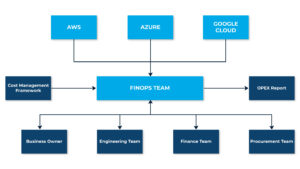Introduction
In today’s business scenario, two distinct methodologies, Finops and Greenops, form a powerful strategy to help organizations optimize their cloud usage and reduce environmental impact. While Finops is concerned with optimizing and controlling cloud spending, Greenops is concerned with making operations more environment-friendly and sustainable. Although both concepts appear unrelated, they support each other in many ways, impacting the environment and costs.
What is Finops?
As businesses rely more on cloud services and infrastructure, the expenses of cloud usage become more complex and volatile. Finops, short for Financial Operations, encompasses a range of strategies and concepts to optimize and oversee a company’s cloud spending. It aims to improve financial efficiency by bringing transparency, accountability, and control over cloud expenses. FinOps assists enterprises in tracking, analyzing, and optimizing cloud-related expenditures to reduce spending while maximizing the value they obtain from cloud services.
The Key Components of Finops
1. Cost Allocation
Resource Tagging: This involves providing metadata or tags to cloud resources to identify which teams or departments are in charge of those resources. Proper tagging helps in accurate cost allocation.
Resource Grouping: Grouping resources by projects, departments, or cost centers, allows for more precise cost attribution. Cloud providers often offer tools to assist with this.
2. Monitoring and Optimization
Cost Tracking: Constantly monitoring and tracking costs is fundamental to Finops. This includes using cloud cost management tools to keep an eye on spending in real time or through historical data.
Resource Right-Sizing: Adjusting resource configurations to match workload demands, avoiding over-provisioning and underutilization.
3. Showback/Chargeback
Showback: This involves providing cost information to various teams or departments without financial accountability. It raises awareness of cloud costs and encourages cost-conscious behavior without imposing direct charges.
Chargeback: In a chargeback model, the costs incurred by different teams or departments are directly charged to their budgets. This fosters more direct financial responsibility and encourages efficient resource usage.
How To Manage Cloud Costs Using Finops?
It becomes essential to analyze and manage cloud costs in cloud computing services to identify the root cause of any inefficiencies. Unplanned cloud costs are typically the result of a lack of visibility into current consumption patterns and historical trends, resulting from unclear or non-existent development procedures or a lack of automated deployment and configuration tools. Controlling cloud costs requires thorough planning, getting the basics right, and involving personnel to ensure proper execution.

The above diagram illustrates the Finops team’s central role in managing and optimizing cloud costs across multiple providers, including AWS, Azure, and Google Cloud. The team employs a cost management framework to track expenditures and produce OPEX reports, delivering valuable insights to key stakeholders such as Business Owners, Engineering Teams, Finance Teams, and Procurement Teams. This collaborative approach ensures the efficient use of cloud resources and aligns financial strategies with operational goals within the organization
Understanding Greenops
Greenops is an operating model that includes all actions/processes and policies to reduce the carbon footprint of IT infrastructure resources. It is closely related to establishing realms of Finops or ITAM (IT asset management), and promoting a culture of environmental responsibility while increasing cost transparency.
Benefits of Using Finops and Greenops
Reduced Cloud Costs: Finops teams can assist organizations in saving money by efficiently managing the cloud costs. This can free up resources for other investments, such as new product development or marketing.
Reduced Environmental Impact: By reducing the environmental impact of cloud usage, GreenOps teams can help organizations achieve their sustainability goals. This can help organizations improve their public image and attract customers and employees concerned about the environment.
Improved Cloud Efficiency: Finops and Greenops teams can assist organizations in enhancing their cloud efficiency, ultimately resulting in improved performance and reliability of cloud-based applications and services.
A few Examples of Finops and Greenops in Action
- Finops can help a corporation identify and properly size its cloud resources. For example, the organization may discover that it is overpaying for specific resources or that a different pricing plan could save it money.
- A company can use GreenOps to optimize its cloud workloads. For example, the company may reduce energy consumption by using more efficient server instances or moving workloads to a region with lower carbon emissions.
- An organization can establish a sustainable cloud strategy by utilizing Finops and Greenops. For example, the corporation may aim to lower its carbon footprint by a specific proportion or to power its cloud workloads entirely with renewable energy.
Conclusion
Finops and Greenops are the two important disciplines that can help organizations optimize their cloud usage, save money, and reduce their environmental impact. By working together, Finops and Greenops teams can help organizations achieve their business goals while being environmentally responsible.





